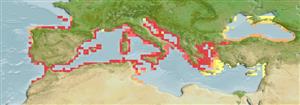分类 / Names
俗名 | 同种异名 | Catalog of Fishes(属, 种) | ITIS | CoL | WoRMS | Cloffa
Teleostei >
Blenniiformes (Blennies)
鱸形目 (Blennies) >
Blenniidae (Combtooth blennies) > Salariinae
Etymology: Salaria: Latin, salar, salaris = trout (Ref. 45335).
More on author: Risso.
Environment: milieu / climate zone / depth range / distribution range
生态学
海洋; 半咸淡水 居于水底的. 亞熱帶的; 46°N - 33°N, 10°W - 42°E
Eastern Atlantic: Atlantic coast from France to Morocco; also in the Mediterranean and Black seas and in the Suez Canal.
東大西洋: 來自法國到摩洛哥的大西洋的海岸; 也在地中海與黑海與蘇伊士運河。
大小 / 重量 / 年龄
Maturity: Lm ? range ? - ? cm
Max length : 13.8 cm TL 雄鱼/尚未辨别雌雄; (Ref. 118193)
背棘 (总数): 11 - 13; 背的软条 (总数): 225; 臀棘 2; 臀鳍软条: 23 - 26. Diagnosis: Mature males with well-developed head-crest and anal gland in the first two anal-fin rays; sneaker males much smaller than nesting males and do not display male secondary sexual characters (Ref. 94108).
Facultative air-breathing (Ref. 126274); Adults occur in the intertidal zone and shallow bottoms, on rocks or sand between pebbles and vegetation (Ref. 5981). Often in brackish waters down to 5 ppt (Ref. 5981). Inhabit crevices or piddock holes, males remain in cavities above water-level during low tide (Ref. 5981). Feed on benthic invertebrates, mainly mollusks, also algae (Ref. 5981). Also ingest large amounts of aquatic insects and pupae (Ref. 94105). Oviparous (Ref. 205). Mature males adopt a passive role during courtship, rarely court females, do not defend nest territory, but provide parental care to eggs. Sneaker males assume a female-like behavior in order to approach the nests of nesting males and parasitically fertilize the eggs (Ref. 94113). Eggs are demersal and adhesive (Ref. 205). Has been reared in captivity (Ref. 35421).
在小圆石与植物之间的岩石或沙子上,出现于潮间带与浅滩底部。 (参考文献 5981) 常见于半咸淡水域向下至 5个 ppt.(参考文献 5981) 栖息于裂隙或者海笋洞, 雄性在低潮的时候逗留在水位上面的洞。 (参考文献 5981) 吃底栖的无脊椎动物, 主要地软件动物, 也藻类.(参考文献 5981) 卵生的.(参考文献 205) 卵是底栖与聚集在一起的。 (参考文献 205) 曾经后面在繁殖场.(参考文献 35421)
Life cycle and mating behavior
成熟度 | 繁殖 | 产卵场 | 卵 | 孕卵数 | 仔鱼
Males court by nodding and undulating movements and drive females to spawning place by biting and butting (Ref. 5981) though this event is rarely done by the males, more or less adopting a passive role in the courtship (Ref 94113). Additionally, males don't defend a territory around the nest (Ref. 94113) though they guard eggs from several females (Ref. 5981, 94113).東大西洋: 來自法國到摩洛哥的大西洋的海岸; 也在地中海與黑海與蘇伊士運河。
Zander, C.D., 1986. Blenniidae. p. 1096-1112. In P.J.P. Whitehead, M.-L. Bauchot, J.-C. Hureau, J. Nielsen and E. Tortonese (eds.) Fishes of the North-eastern Atlantic and the Mediterranean, volume 3. UNESCO, Paris. (Ref. 5981)
人类利用
渔业: 自给性渔业
更多信息
参考文献养殖养殖信息品种遗传学Electrophoreses遗传率疾病加工NutrientsMass conversion
工具
特别资料
下载 XML
网络资源
Estimates based on models
Preferred temperature (Ref.
123201): 15 - 21.2, mean 18.8 °C (based on 615 cells).
Phylogenetic diversity index (Ref.
82804): PD
50 = 0.5312 [Uniqueness, from 0.5 = low to 2.0 = high].
Bayesian length-weight: a=0.01072 (0.00842 - 0.01363), b=3.02 (2.95 - 3.09), in cm total length, based on LWR estimates for this species (Ref.
93245).
营养阶层 (Ref.
69278): 3.6 ±0.0 se; based on diet studies.
Generation time: 2.2 ( na - na) years. Estimated as median ln(3)/K based on 1
growth studies.
回复力 (Ref.
120179): 高度, 族群倍增时间少于 15个月 (K=0.50).
Fishing Vulnerability (Ref.
59153): Low to moderate vulnerability (25 of 100).
Nutrients (Ref.
124155): Calcium = 127 [21, 405] mg/100g; Iron = 1.39 [0.52, 4.55] mg/100g; Protein = 4.16 [0.45, 7.88] %; Omega3 = 0.443 [0.183, 1.088] g/100g; Selenium = 8.2 [1.8, 25.0] μg/100g; VitaminA = 25.1 [8.9, 69.6] μg/100g; Zinc = 1.24 [0.59, 2.46] mg/100g (wet weight);
